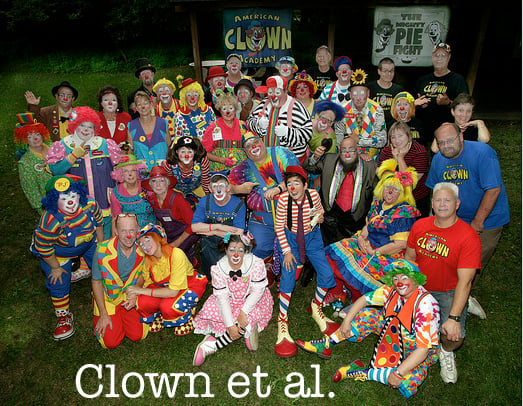The scenario: It’s Sunday evening, and you’ve fallen way down the rabbit hole as you research your topic for your psychology class research paper. You’ve found so much good stuff that you’re positively giddy!
Seeking and consuming information can be addictive, you know.
Mmm. Dopamine.
You’re feeling pretty good about your level of understanding and can hardly wait to turn your newfound knowledge into a masterpiece when you see it. At the bottom of your assignment sheet, in bold print, your professor has written, “Please include appropriate APA citations.”
You glance nervously at the MLA-style Works Cited you’ve started. Or, worse yet, at your list of raw URLs and notes like “p. 23 green textbook by Steve B.” You start to sweat a little.
Buzzkill, man.
If this scenario sounds all too familiar, take a deep breath and stop panicking.
You’ve got this.
I’m going to help you learn how to write APA citations (and reference list entries!) in 4 easy steps.
APA Citations: What They Are and Who Uses Them
Before you learn how to write APA citations, it helps to understand what the APA is.
The acronym “APA” stands for the American Psychological Association, a US-based scientific and professional organization for psychologists. This organization has its own style guide, including a system for citing sources in research.
But wait, you say. I’m no psychologist.

That may be true! Maybe you’re a still a psychology student, or maybe you’re a biology major taking psychology as an elective, or maybe you’re majoring in something like math and your professor just really digs APA style.
Even though the APA is an organization for psychologists, its citation style is used by professionals and students in a variety of disciplines, including those in the fields of sociology, business, economics, nursing, business, and others.
And if you’re going to be a professional in one of those fields one day, knowing how to cite your sources in a standardized format ensures that you are on the same page, so to speak, as your colleagues in the field. (We’ve said it before: formatting matters!)
Now, let’s talk about the citations themselves.
An APA citation has two parts:
- the in-text citation that appears in the actual text of your paper, and
- a reference list entry that appears in the list of sources you consulted when writing your paper.
The purpose of the in-text citation is to point your readers toward the reference list, where they can see the full list of sources you paraphrased or quoted. This is really important, because “green textbook by Steve B.” is pretty much meaningless to anyone but you.
Now that you know what APA citations are, let’s learn how to construct them.
4 Easy Steps for Creating APA Citations (and Building Your Reference List at the Same Time)
Writing APA citations is easy-peasy. No, really; I promise!
It’s so easy, in fact, that I’m going to recommend that you take it a step further and write your reference list at the same time. This saves you time as you’re putting the finishing touches on your paper and ensures that you never have to scramble to figure out which Smith wrote which book in 1997.
When you go through this process is up to you. But why not get it out of the way?
It’s a really good idea to cite your source the second you use another author’s idea — paraphrased or quoted — in your research paper.
This ensures that you don’t accidentally forget to credit an author, and it saves you from last-minute panic attacks as you scramble to remember where you found a piece of information.
Okay, so now that you know when to put your references together, let’s dig into how.
Step 1: Identify the source type
The type of source you’re citing actually doesn’t make a big difference when it comes to creating the in-text citation. But since we’re killing two (proverbial, of course) birds with one stone by creating the reference list entry alongside the citation, you should define your source type from the get-go.
Many of the sources you cite will be obvious: books, journal articles, magazine articles, and so forth. Other sources, such as white papers and government documents, can be a little harder to pin down.
Knowing what kind of source you’re citing leads you right into step 2.
Step 2: Locate the structure for the source and plug in your information
Each type of source that you might need to cite follows a specific structure. Once you have nailed down exactly what you’re working with, you need to find the structure for the source’s reference list entry.
Then, creating your reference list entry is as simple as plugging in the information.
I’ll save you some trouble and list the basic structures for some of the most common sources you will encounter:
Book
Author, A. (Date). Title of book in sentence case. Publisher’s location: publisher.
Journal article
Author, A. (Date). Title of article in sentence case: Capitalize the first word that comes after the colon. Title of Journal in Title Case, volume number(issue number), page range.
Web page
Author, A. (Date). Title of document found on web page in sentence case. Retrieved from http://www.URL.com
Not all sources are this common or as cut-and-dried, though. If the type of source you’re citing is more complex, try the APA resources from the Purdue OWL. This site is a great resource for citation structures of all kinds.
The APA Style Blog is another great resource for citing less-common sources. For instance, this post describes how to cite a variety of web-based documents and pages that fall outside of the standard form. It also provides helpful advice on citing legal documents, personal communication, and more.
Sometimes, you’ll discover that a source is missing a piece of information — don’t panic! Bookmark this handy chart from the APA Style Blog; it tells you how to handle situations such as missing authors, missing titles, and so forth.
Finally, if you run into a source that is truly difficult to cite, visit your university library or its website. It likely has a copy of or subscription to the full APA Style Manual that you can peruse for those truly hard-to-cite sources.
Step 3: Add to the reference list
As I mentioned before, I strongly recommend that you write your reference list as you cite sources in the text. I can’t tell you how often I run into stray in-text citations without reference list entries when I edit.
Can you imagine trying to remember what (Smith, 1997) refers to several weeks after you cited it? Save yourself the trouble — trust me.
Now that you’ve plugged the information into the structure for the citation, it’s time to add the reference list entry to your list.
Place your reference list entries in alphabetical order when you add them to the reference list — not the order in which you cite them. Still not sure if you’re getting it right? Check out this example reference list I started:

Step 4: Create the in-text citation
Once you’ve written your reference list entry, the hardest part of citing sources in APA is over. Woohoo! Thankfully, there aren’t too many rules to remember when it comes to creating APA citations themselves.
For most citations, you need three pieces of info, tops: the author’s name(s), the year the source was published, and — especially if you’re quoting directly — the page number on which the information is found. By the time you reach step 4, you already know all of this!
The basic structure looks like this:
(Author, Year, p. #)
That’s not too scary, is it? If your source has two authors, in-text citations become more complex — but only slightly:
(Author & Author, Year, p. #)
If there are three to five authors, you format your citations like so:
(Author, Author, Author, Author, & Author, Year, p. #)
….but only the first time you use them. Rather than packing all of these authors into every citation like it’s a clown car, you can use the handy-dandy Latin phrase ‘et al.’ (please don’t forget the period after ‘al.’!) to save yourself some typing:
(Author et al., Year, p. #)
But what about those journal articles with six authors? Ten? you may wonder. Do I really have to write all those out?
Thankfully, you don’t! You can use the ‘et al.’ abbreviation from the get-go if there are more than five authors. Phew.
This blog post from the APA includes a handy chart to help you keep those rules straight.
Now, let’s look at a couple of real-world examples. Let’s say that you really want to use this quote from the preface of Clay A. Johnson’s book The Information Diet in your paper:
“In the world of agriculture, we now have factory farms churning out junk food; and in the world of media, we now have content farms churning out junk information.”
Now, let’s add your parenthetical citation:
“In the world of agriculture, we now have factory farms churning out junk food; and in the world of media, we now have content farms churning out junk information” (Johnson, 2011, p. xi).
That’s it! Notice how the period goes at the end, after the citation, rather than before the quotation marks.
One cool thing about APA citations is that you actually have options. (I love options). If you want to change things up a bit, you can also slip the author’s name and the date into the running text:
As Johnson (2011) states, “In the world of agriculture, we now have factory farms churning out junk food; and in the world of media, we now have content farms churning out junk information” (p. xi).
Here’s another example. Let’s say that you also found a great journal article about dopamine by K.C. Berridge and T.E. Robinson and need to cite it:
In addition, “dopamine systems are necessary for ‘wanting’ incentives, but not for ‘liking’ them or for learning new ‘likes’ and ‘dislikes’” (Berridge & Robinson, 1998, p. 309).
More Resources
After a while, creating APA citations for common source types becomes second nature. While you’re still getting the hang of formating them, though, free online citation generators can be really helpful tools.
Bibme.org is one such tool. It’s most helpful for common sources, such as books and journal articles, but you can use its built-in search function to search for certain sources and auto-populate the information for you. (It’s not a bad idea to verify the information, though).
Then, with the click of a button, it generates an APA citation that you can copy and paste into your reference list, save to your account, and more. You can even generate a parenthetical citation.
Son of Citation Machine has a very similar interface and functionality; you simply plug in your information (or use the search function) to receive both a reference list entry and in-text citation that you can copy and paste into your paper.
Most automated citation builders cite a limited range of document types, but Citefast includes a few document types that the previous two builders don’t, such as government publications and podcasts.
Want to test your skills? Play a few rounds of APA Psych Out from Williams College Libraries, or check out three additional APA citation games from the Peru State College website.
Think you’ve got the hang of it? Let us check your work before you turn it in!

